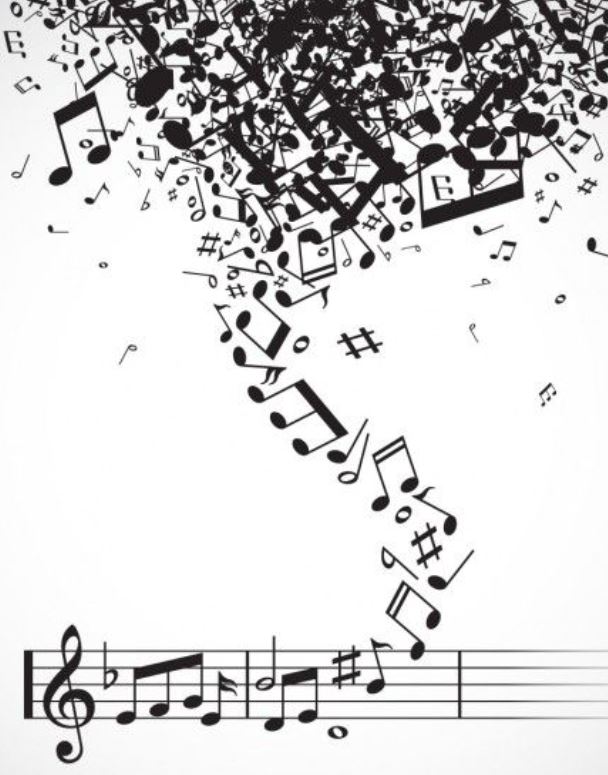
As the saying goes, how long is a piece of string?
I know the answer can be very long so I avoided music theory for quite a while. I vaguely recall sitting some AMEB exams as a kid, but the theories I touched on in classical piano were worlds away from the terms I started hearing as an adult when I picked up the guitar. Of course, if I’d studied jazz or rock piano instead, that would have been different.
I’ve done a pretty good job of steadfastly avoiding scales or knowing where notes are on the guitar. How boring, when there is the instantly accessible world of TAB and chord shapes. I’d had enough of the dry stuff in my youth and was determined to be free of it. Then I tried a guitar lesson in 2019 (when I dusted off the instrument) and the teacher told me that my area of weakness was theory. So I went off and binged on YouTube videos by Jake Lizzio’s Signals Music Channel for a week or two (which I discovered when searching for ‘gypsy’ + ‘scale’).
That opened my eyes. I finally understood phrases that seemed elementary to many guitarists, like ‘phrygian mode’ and ‘minor-7-flat-5′. I even had a way of understanding other genres, like the gypsy world, which often uses Harmonic Minor and its 5th mode, Phrygian Dominant. Sound like gibberish to you? It did to me. And intimidating, right? That’s how I felt, which is why I’m keen to share my new knowledge with anyone else in that boat, especially if you already have a classical background in another instrument and can’t get your head around the lingo used by most guitarists.
Straight up: if you want a more entertaining and digestible (not to mention, extensive) lesson on music theory, head over to Jake’s YouTube channel. I haven’t written my notes with entertainment in mind. It is basically regurgitation, as a way to put my thoughts in order so I can refer back to them anywhere, anytime.
Western music works off 12 chromatic notes within an ‘octave’. This is the Chromatic Scale of 12 notes. Basically it’s every note (black and white), as laid out on the piano within once octave. Some other musical cultures work off more than 12 notes.
Scales are defined by the spaces between these notes. If all 12 notes are played (C, C#, D, D# etc.), then all notes are said to be a semi-tone (S) space apart. A Major scale has only 8 notes, not 12 (hence the name ‘octave’, deriving from 8). That means 4 notes have been dropped from the Chromatic Scale of 12.
Like all scales, the Major Scale is built around a specific spacing pattern. To describe this pattern, we use T (for tone/whole step/2 notes) and S (for semitone/half step/1 note). Where you see a T, a note has been dropped, as per the chart below. If you were to look at this on the piano, you would see that all the black keys have been dropped from the C Chromatic Scale to form the C Major Scale.

The guitar is much more egalitarian than the piano because there is no distinction between black and white keys. Every note on the fretboard looks much like the other. Take a look at the Major Scale for bE on the piano. These are the notes:

On the piano, you would have to learn a new fingering pattern for this (all the flatted notes will be black notes on the keyboard) but on the guitar, you simply move the same fingering pattern to a different starting position on the fretboard. This means you need to dedicate a lot more time to learning scale shapes (and their corresponding chords) on the piano than on the guitar. Because of this, it would be much harder to be an improv/jazz muso on the piano than on the guitar.
There are many more scales than the Chromatic and Major ones, each with its own unique spacing pattern between notes. These include the Pentatonic Major, Pentatonic Minor, Blues, Harmonic Minor, Hungarian Minor, Double Harmonic Minor, Japanese, Egyptian, Melodic Minor (more commonly used in jazz), Bebop, and so on.
The place to begin is undoubtedly with the Major Scale. All chord formulas relate back to the Major Scale, regardless of which key the chord is in. (Don’t worry if that’s confusing. Skip the rest of this paragraph if you need to and come back to it after reading later sections.) For example, the second chord position of the Harmonic Minor Scale is called a full diminished chord (1-b3-b5-b7). This chord is defined by the Major Scale, not the Harmonic Minor Scale, even though the key is not a Major key. If, for instance, position 1 = C, then C diminished chord is C, bE, bG, bB, which is worked off the C Major scale, not the C Harmonic Minor scale. Don’t freak out. I’m jumping way ahead in here but a section on scales is really where this should be noted in case you already have some musical knowledge. If not, keep reading and it should make sense later. The point is that all chord formulas refer back to the spacing of the root note’s Major Scale, so it’s the most important scale to learn.
After the Major Scale, it’s good to learn the Natural Minor Scale. It’s sometimes called the Relative Minor Scale because it uses the same notes as its related Major Scale. (It is also called the Aeolian Scale, which is its modal scale name. Modes will be described in the next section.)
Look at C Major Scale on the piano. It uses only white notes. Now start a scale at A using the same white-only notes. Notice how the C scale sounds sunny and the A scale sounds sad, even though they use the same notes? That’s the difference between Major and Minor scales. Because these scales use the same notes, C Major and A Minor scales are ‘related’.
It is important to know that there are a few scales called “Minor” (Natural, Melodic and Harmonic being the most common). If you just hear the name “Minor”, it will be this Natural (Aeolian) Minor that I described in the previous paragraphs. The majority of chords (& keys) in Western music are either Major or (Natural) Minor.
Because the Natural Minor is the next most commonly used scale after Major, it is good to learn it next. Its scale spacing pattern is TSTTSTT. Another reason to learn it is that it is very similar to the Harmonic Minor scale (TSTTST#S), so it’s a useful stepping stone towards learning that exotic sound if it appeals.
After learning the Major and Minor scales, it seems most guitarists like to learn the Pentatonic Minor, Pentatonic Major, and Blues scales, which are just simplified versions of the Major and Natural Minor scales.
The last thought on scales is this website to locate whichever one you want on the fretboard: fretastic.com
As described Section 1, there are different scales (tonalities) and the first one to learn is the Major Scale, whose spacing is TTSTTTS. Because each octave consists of 7 unique notes (the last note in an octave is the same as the first), each scale consists of 7 “modes”.
A mode is also a scale but it begins at a different point along the parent scale (AKA pure scale). Pure scales differ by spacing pattern. Modal scales differ by where they start along that spacing pattern. For example, Major Scale (a pure scale) is TTSTTTS. If you start at the second position, the 2nd modal scale would be TSTTTST. The third position (3rd mode) would be STTTSTT, and so on. The spaces between the notes don’t vary; just the starting point.
Because of this, the key signature of each mode (how many sharps or flats are in the key; the black notes on a piano) does not change, because it is the same collection of notes being used. (Don’t worry if you don’t understand key signatures. They are explained in the next section.)
All these modal scales are therefore known as relatives, because they share the same notes. For example, in Section 1 I pointed out that A Minor Scale is a relative of C Major Scale. They have the same key signature. (A is the 6th starting position along the C Major scale, or conversely, C Major is the 3rd mode of the A Minor scale.) Remember that word, “relative”, because later I will introduce “parallel” scales.
Roman numerals refer to note-positions along a scale, regardless of whether the scale is pure or modal. For instance, the progression of ii-v-i in a song refers to D-G-C if in the key of C Major, or B-E-A if in the key of A Minor. (If you already know chord theory, I’m omitting that here to keep it simple. That gets introduced in the next section.)
Each modal scale has a unique name. The modal scales within the Major Scale have different names to the modal scales within the Harmonic Minor Scale (or other pure scales). Below are the names for Major modal scales. They are commonly used by guitarists, especially lead guitarists:
- I = Ionian (AKA Major)
- II = Dorian
- III = Phrygian
- IV = Lydian
- V = Mixolydian
- VI = Aeolian (AKA Minor or Natural Minor)
- VII = Locrian
Now that these modal scales have names, you can use numbers to refer to their own modes. For example, you can refer to the 2nd mode of the Lydian scale, and so on. That’s much less confusing than saying “the 2nd mode of the 4th mode of the Major scale”!
Each modal scale has its own ‘sound-flavour’. This may not seem particularly useful when playing each relative modal scale, for example, C Ionian, D Dorian, E Phrygian, F Lydian etc. After all, that would sound as if you were playing within the same overall C Major scale (which you would be). The flavour-difference would be more apparent if you played each scale starting on the same note, like this:
- C Ionian = TTSTTTS (has no sharps or flats)
- C Dorian = TSTTTST (has bB and bE)
- C Phrygian = STTTSTT (has F#, C#, G#)
- C Lydian = TTTSTTS (has F#)
- C Mixolydian = TTSTTST (has bB)
- C Aeolian = TSTTSTT (has bB, bE, bA)
- C Locrian = STTSTTT (has bB, bE, bA, bD, bG)
All of these scales are not relative; they are parallel. They have different key signatures (different black notes on the piano; the sharps or flats) but they all start on the same note, C.
If you are into improvisations (lead or jazz), you’d want to know all these different scales like the back of your hand. Unfortunately for pianists, learning all the modal scales within Major (ignoring the modal scales of other pure scales, like Melodic Minor and Harmonic Minor) means learning 77 scale patterns. This is thanks to the awkward arrangement of black and white notes on the keyboard. (11 semitones x 7 modal positions = 77.) Guitarists only have to learn 7 scale shapes, one for each mode (though they can learn extra ones to move further up and down the fretboard if they want to). The guitar is just a much more flexible instrument that way. When parents have said that they want their kid to get a good grounding in music by starting on the piano, I sometimes want to point out that the piano has its own weaknesses. (It also has some great features, of course, but not enough parents seem to understand its shortcomings.)
Now back to the flavours of each modal scale in Major:
- Ionian (AKA Major) = the sunniest, chirpiest of all Major sounds
- Dorian = a Minor sound but not as sad as Aeolian
- Phrygian = an exotic Minor sound (but not as exotic as the 5th mode of the Harmonic Minor scale, whose name is Phrygian Dominant)
- Lydian = a Major sound sound that is a bit curious and dreamy. It is less “stable” than the other Majors.
- Mixolydian = a Dominant 7th, Major sound. It is the fun, rockier sibling to Ionian
- Aeolian (AKA Minor) = the most melancholic Minor sound
- Locrian = neither a Major nor Minor sound but a Diminished sound, which can be quite boring, incongruous and uncomfortable. Jake Lizzio refers to this scale as “the leftovers”.
If you’re classically trained, you’ll know all about key signatures. If you’re not, then the easiest way to understand them is by looking at a piano. All the black keys are called sharps if they are to the right (so G# is to the right of the white G key) and they’re called flats if they are to the left (so bG is to the left of G). If you raise a note by a semitone, then it has been “sharped”. If you lower it by a semitone, then it has been “flatted”.
Remember the Major Scale spacing? TTSTTTS. Each T spacing means a note is missing. If you start the scale on C, each missing note on the piano is a black key, which means the key signature of C Major scale has no sharps or flats. If you applied the same spacing (TTSTTTS) when starting on F, then you would land on bB eventually, so the key signature for F Major is bB. (It has only one black note in it.)
As for when to call a note a sharp or a flat, that seems unnecessarily confusing at this point so if you’re interested, look up “Circle of Fifths”. It’s not highly relevant; the main thing to note is that classical musicians learn key signatures mainly because it impacts how they read sheet music. I’m sure there could be a much better design for music annotation (TAB + timing for the guitar, for instance) but that’s how it evolved.
This is a summary of all the key signatures in both sharps and flats.
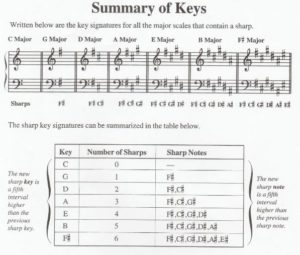
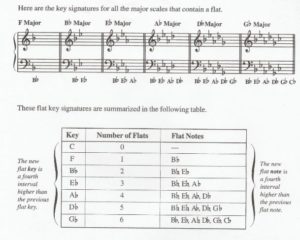
I only went to Grade 4 or 5 in piano (it was a long time ago, over 30 years) so I’m not sure how far classical theory goes. I recall mentions of the Minor Scale but I, like every other pianist I personally know, never heard of Minor’s modal name, nor any of the other modal scales. So here’s the thing for all you classical musos: each key signature does not just apply to the Major Scale or Minor Scale; it applies to all the other modal scales too.
The table below is useful, not only to work out the key signature of any modal scale within the Major world, but also to know what notes are included in that key, and how you might build chord progressions within that key. (You could build a similar table to work out the modes of other pure scales, such as Harmonic Minor).
For example, imagine you are playing in the key of C Mixolydian. Mixolydian is “the 5th mode of Major” so run your finger down the fifth column until you find C. You will see that this scale shares the same key signature (bB) as F Major scale. (Does this not wig-out other classical pianists? Your ‘home note’ is C, even though the key signature is bB.)
Next, let’s say you want to play a ii-v-i chord progression in the key of C Mixolydian. (Chord progressions will be described in Section 6 so I’m jumping the gun here.) The 2nd position note for C Mixolydian is D, as you can see from the table below. The 2nd position chord for any Mixolydian key is a Minor chord so you want to build a D Minor chord as the “ii” chord. (Again, this will be clearer in Section 6.)
The formula for a (basic) Minor chord is 1-b3-5 (chord formulas are explained in Section 4). To build this chord based on the formula, you can look back at this table but now DON’T look at the C Mixolydian scale; look at the C Major (Ionian) scale. As I said in Section 1, all chord formulas are based on the Major Scale, regardless of what key they are in. For D, the Minor chord (1-b3-5) is D-F-A. (The third note in the D Major scale, F#, has been flatted (b), which means it has dropped by a semitone from F# to F.) By using this table, you’ve determined that D-F-A is the second position chord in the key of C Mixolydian.
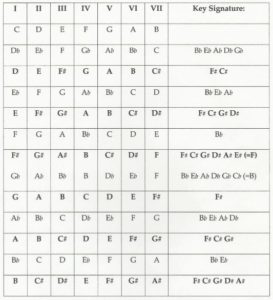
This is a link to see the table in a bigger format. I will also include it in a future post called ‘Useful Music Charts’.
UPDATE August 2021:
I’ve just started looking at videos by Brian of Active Melody online and he’s got a much nicer way of summarising the notes/chords of each key. He uses the Cirle of Fifths chart. For more on this, see Section 12 below, which has very handy charts for printing.
Chords are a collection of notes that are played all at the same time or one after the other, such as when ‘arpeggiated’ (in an arpeggio).
On the guitar, it’s common to hold a chord with the left hand and either strum or finger-pick notes with the right. In that sense, guitarists are immediately more familiar with chords than pianists. Moreover, guitarists don’t need to learn a lot of chord shapes. If they want to transpose from one key to another, they only need to use a capo and instantly they are in another key while using the original chord shapes. Pianists need to apply a whole new set of chord shapes if they want to change key.
The most basic chord consists of three notes (a triad) but four is not uncommon (known as extended chords). Chords with more than 4 notes are worked out over two octaves and are more common amongst jazz-heads.
All chords follow a formula, such as 1-3-5 for the Major chord triad. These numbers relate back to the position of notes within the Major scale. For example, in C Major (Ionian), those three notes would be C-E-G.
The “root note” is position 1 of the chord. (Not to be confused with a “tonic note”, which is “home note” of the key/overall song, not just a chord.) In our example, C is the root note.
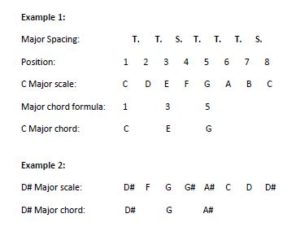
A Minor chord has a formula of 1-b3-5. The only difference between the Major and Minor triad is whether the third note is natural or flatted (b). The third note is therefore a very important note when defining the flavour of a chord (sunny versus reflective).
Some songs avoid playing this third note by playing ‘power chords’ in the rhythm section. Power chords consist of 1-5-8. In an octave, positions 1 and 8 are the same note, so this power chord would be C-G-C for the C power chord. That way, the lead guitarist is free to improvise over the top of the song in either a Major or Minor scale, and can switch between them, since there is no defining b3 note being played by the rhythm section. The main thing to note here is that certain notes are quite defining when present and my music theory guru (Jake Lizzio) says to pay attention to 3, 5 and 7.
Here’s a tip for piano players when they play Major and Minor triad chords: if you play the chord with your thumb on the root note, then the 5th note will always be the same colour (white or black) as the root note EXCEPT for the keys of B and bB, where 1 and 5 will be opposite colours. The 3rd note will be either in the middle of these notes (for Major) or just to the left of the middle (for Minor).
After Major and Minor chords, the next type to learn is the Dominant 7th chord, which is often just to referred to as “the 7th” or “Dom 7th”. The fact that there is a number 7 in the name indicates that there are 4 notes in this chord, not 3, so it is an extended chord, not a triad. Note: you can also extend the basic Major chord to become Major 7, and the Minor chord to become Minor 7. There is even a Major Minor 7, which most people don’t use but I’m telling you so you’re aware of the potential “7” landscape out there. If you just hear “7”, it is the Dom 7 being referred to.
The formula for Dom 7 is 1-3-5-b7. If you were to drop the 4th note, this chord would be Major, and it is often played as such. Major is part of Dom 7 so the terms can be used interchangeably sometimes. (Dom 7 is not part of Major.) This illustrates the difference between triads and extended chords. The former is more rustic and therefore more versatile. The latter is more specific and nuanced. Jazz uses a lot of extended chords.
Just as Major and Minor chords are distinctive by their sound (sunny vs reflective), Dom 7 also has a defining sound. It wants to “resolve”, generally to the Major or Minor chord that is 5 steps down in the scale. Once again I’m jumping the gun so this will be explained further in Section 6 and 7.
The defining note for Dom 7 is of course the flatted 7th note (otherwise it’s just the Major chord). Its next defining note is 3 (which differentiates it between a Major and Minor overall sound). If you were to extend this chord even further (over 2 octaves), then you would get a Dom 9 chord, whose formula is 1-3-5-b7-9. With 5 notes, you may not want to play all of these notes, especially on the piano with one hand. If you were to drop any notes from this chord, it would be 1 and 5, since the other 3 are so defining. In this way, chords can be hard to recognise because they are incomplete, yet the same functionality might be served.
Since I’m pointing out how hard chords can be to recognise (if you were to analyse a complex piece of music), let me introduce the idea of chord inversions. This is where the order of the notes is changed, yet it is still the same collection of notes. For example, C Major chord is CEG (1-3-5), but it could also be played EGC (to the higher C) or GCE. Because of this, it helps to understand what key the song is in and from that, identify the scale tone chords (explained in Section 6) so that you can identify whether GCE is in fact a chord inversion of C Major or some other kind of G chord. But don’t worry, the vast majority of popular songs (be they rock, pop or metal etc.) are not that complex. Also, it’s easier to write a song than analyse someone else’s.
Another chord that wants to resolve back to the tonic note is the diminished chord, which is often referred to as “Dim 7” or a circle. It has 4 notes and its formula is 1-b3-b5-bb7 (=6). Because this 6 note sounds so incongruous, the chord is often played with just b7, instead of bb7. The new chord formula of 1-b3-b5-b7 is known as the Half Diminished chord or Minor 7 Flat 5, often annotated as a circle with a line through it. Basically, Dim 7 and Min7b5 are interchangeable EXCEPT if you want to shift between different chords using the Dim chord. (One Dim chord can belong to 4 different keys and is therefore a useful pivoting chord. This will be explained in Section 7.) The diminished triad (1-b3-b5) is very rarely used.
The next chords to learn are the suspended chords. There are two varieties, Sus 2 (1-2-5) and Sus4 (1-4-5). The useful thing about these chords is that they are fairly rustic (just triads) and they are not defined as Major or Minor (the 3/b3 is missing). They are useful for breaking up sustained periods of just Major or Minor (shifting back and forth to the Sus chord). Try it out on the piano by swapping between CFG, CDG and CEG (Sus4, Sus2 and Major). Sus chords are kind of ‘twangy’-sounding.
From here, you don’t need to learn more chord shapes as you have enough to cover most song progressions. If you’re interested in gypsy-sounding music, you might want to learn the Augmented chord (1-3-5#). There are of course many more chords. There are also “slashed” chords, written like this: C/G. That means C Major played over a G bass note. (If you think about it though, that’s just a chord inversion, because G is already within C Major chord.)
This is a summary of the main chords to learn:
- Major triad= 1-3-5
- Major 7 (an extended version of the triad) = 1-3-5-7
- Minor triad = 1-b3-5
- Minor 7 (an extended version of the triad) = 1-b3-5-b7
- Dominant 7 = 1-3-5-b7
- Dominant 9 = 1-3-5-b7-9
- Diminished 7 = 1-b3-b5-bb7
- Half Diminished (Major 7 Flat 5) = 1-b3-b5-b7
- Suspended 4 = 1-4-5
- Suspended 2 = 1-2-5
- Power chord = 1-5-8
- Augmented chord = 1-3-5#
Finally, each chord has its own notation options. It is important to become familiar with these, as per the chart below. If the resolution isn’t clear, look for a post I write later called “Useful music charts”.
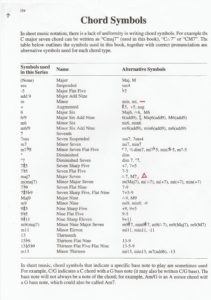
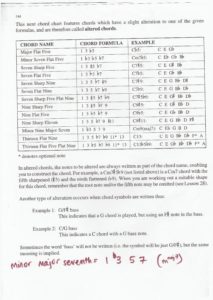

Finally, remember how a Major triad (1-3-5) is part of a Dominant 7th chord (1-3-5-b7)? That means that if you see a Dom7 chord in a song, you could substitute it for a plain Major triad chord. Alternatively, you could use a different Dominant chord, like Dom9 (adding a note, instead of dropping one). The same “chord function” will be applied. Likewise, a Minor triad is part of a Minor 7, Minor 11, or Minor 13 chord. In short, some chords are interchangeable. The chart below offers further substitutions (you can change in either direction, from basic to complex or vice versa).

I’ve described scales and chords. This section now looks at how chords fit within a scale (i.e. within a key).
Roman numerals are used to notate the position of each root note within a scale (i-vii). As a chord within a scale, we add the shorthand notation for the chord type. For example, if you see iim, that means that the second note takes a Minor chord. If you see v7, that means the fifth note takes a Dominant Seventh chord. If the chord is a Major triad, it has no notation, like this: i (= Major triad in the first position). However, if the chord is a Major 7 (extended Major chord), its notation is like this: imaj7 or i with a triangle after it. Refer to the charts in the section above for more on chord annotations.
Keep in mind that a root note is different to a tonic note. The root note relates to a chord. The tonic note relates to a scale/key. In other words, the tonic is in position i.
To build a chord, we add notes in third intervals (meaning we skip alternate notes) within a scale. Look at the notes in C Major scale: C-D-E-F-G-A-B. If you start on the first note and then jump to the third, and again skip one note to jump to the fifth, the chord for C will be CEG, which fits with the Major chord formula (1-3-5). If you do the same but starting on the second note (skipping alternate notes), the chord for D will be DFA, which fits with the Minor chord formula (if you look at the D Major scale, it has F#, not F, so the 3rd note has been flatted; 1-b3-5). Remember, a chord formula relates back to a root note’s Major scale, regardless of what scale/key you are working it out from. Keep repeating this process for each root note in the scale to see what chord types emerge, like so:

That is how you build “scale tone chords”. Every Major scale will have the following diatonic chords: i-iim-iiim-iv-v-vim-vii0 (the circle is annotation for the diminished chord. Strictly speaking, this would be a triad diminished chord but as noted earlier, this is rarely played. Half diminished chords are the norm.)
What is you jumped again to a fourth note to build extended chords, not just triads?
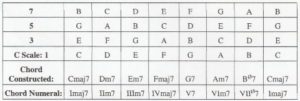
Every Major scale will have the following extended diatonic chords: imaj7-iim7-iiim7-ivmaj7-v7-vim7-vii0.
How cool is that? If someone tells you that a song is in a Major key, you can play chords that will fit. If they say they will play a “ii-v-i” progression in C Major for example, you’ll know that that means D Minor chord followed by G Major chord, then C Major chord.
But even better, by using the same intervals-method above, we can figure out the chords for every modal scale, not just Ionian Major, like so:

I know the resolution above is tiny so here is a link to see it in full. I’ll also type it out below for clarity because it’s an important one. It comes in use later when I describe being able to substitute parallel modal chords (See Section 7. For parallel chords, look within a column. For relative chords, look within a row.)
- Major (Ionian) = i-iim-iiim-iv-v7-vim-vii0
- Dorian = im-iim-biii-iv7-vm-vi0-bvii
- Phrygian = im-bii-biii7-ivm-v0-bvi-bviim
- Lydian = i-ii7-iiim-iv#0-v-vim-viim
- Mixolydian = i7-iim-iii0-iv-vm-vim-bvii
- Minor (Aeolian) = im-ii0-biii-ivm-vm (but often played as v7) – bvi-bvii7
- Locrian (“the leftovers”) = i0-vii-biiim-ivm-bv-bvi7-bviim

In the section above, we looked at scale tone chords. You make these by jumping over alternate notes (in thirds) within a scale. From this, we can work out the chord type for each position within a scale, from i to vii.
The best way to get a feel for these chords is on the piano, because C Major scale is already laid out nicely via all the white notes. Every chord can be played by your thumb, middle finger and pinkie, allowing you to skip two notes in each chord (the index and ring fingers). Start with your right hand’s thumb on C to play the i chord, and then jump around randomly between all the other chords. Now play the chord at G (v), followed by C (i). Notice how it sounds like you’ve come home? The fifth chord wants to resolve. This “pulling back” sound is called cadence. There are different kinds of cadence, defined by which chord leads back to the tonic, such as plagal, authentic, Latin and Andalusian.
Now check out a Minor key (Aeolian). Since A Minor uses all the same white notes on the piano as C Major, you can jump around with all the same chords as before – just start off with your thumb on A this time, since that is now position i. Which chord sounds like it wants to return to i? Again, the fifth chord, Em (v).
Even though you played the same collection of chords each time, there was a different ‘home sound’ (tonic chord) and lead-in chord. That’s because in each instance, you played in a different key, albeit with the same key signature. First you played in C Major, and then in A Minor.
At the end of the day, the specific note that a key is in doesn’t matter too much. You can transpose keys (as in, key-notes) and keep the same feel of the song. This is best exemplified on the guitar, where all you have to do is add a capo to the fretboard to change the key-note. This is often done to suit a singer’s vocal range, higher or lower.
What does matter is if you change a key’s mode, rather than its key-note (for example, from A Major to A Minor) or scale (for example, from A Major to A Harmonic Minor). The mode/scale-type has a huge impact on the feel of a song.
The selection of chords that a song is in will define the key’s mode/scale. Refer to this chart and this chart from the previous section to know what I mean by a collection of chords defining a key. In our example above, when you played G (v) leading to C (i), both these chords were Major, and this helps you identify that the key was in C Major. When you played E (v) leading to A (i), both these chords were Minor, which helps you know that the key was A Minor.
Next try playing the most common chord progression in rock/blues: the iv-v-i progression. Do this first in the key of C Major, and then in the key of A Minor. Notice the different feel of each phrase, even though they have the same progression? That’s because they are in different key-modes. The chords will be:
- F-G-C (for C Major key. Major = sunny)
- Dm-Em-Am (for A Minor key. Minor = reflective)
Using Roman numerals (like iv-v-i) to annotate chord progressions like
this is common within music theory. It allows you to transpose between
keys and can help you recognise the different function of each chord.
It’s important to note that many songs change keys within the song, and this can be confusing because suddenly those Roman numerals will refer to a whole new set of notes. NB: Changing keys within a song is called ‘modulating’. Changing keys between different versions of a song is called ‘transposing’.
This is an example of how a song might look through different key changes:
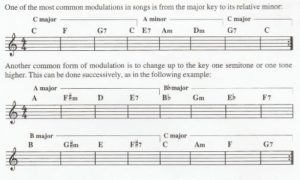
Below is the chord progression for George Harrison’s song, “While my guitar gently weeps” (with a clearer view here). It modulates from A Minor in the verse (albeit with a Major iv chord, which is fairly common for the Minor key) to A Major in the chorus (using a Major triad instead of full Dom 7 chord for the v chord):
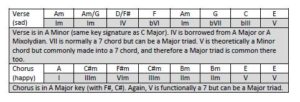
In this case, the song is not modulating between “relative” keys. It is modulating between “parallel” keys. That’s because both the verse and chorus use the same key-note (A), but are in different modal scales (with different key signatures). Another example of this is “Norwegian Wood” by The Beetles, which modulates from E Mixolydian to E Dorian.
Modulating between keys is described further in the next sections (on Applications). I wanted to introduce the idea in this section to point out that a chord progression isn’t always straightforward when there is a key change within a song.
The main thing to remember is that different modes (modal scales) have different feels, as per Section 2. However, within those scales, different positions take different diatonic chords. Jake Lizzio jokes about ‘the sensitive female chord progression’ for pop rock, because other than the tonic chord, which is a Minor chord (‘sensitive’), all other chords are Major (‘upbeat’). That means the song progression (in Aeolian) can be melancholic yet also boppy. It goes something like Im-VI–III-VII. Once you have a song progression, you can try playing it in different modes, noting that the mood will also be changed.
Now you have an understanding of scales, chord types and scale tone chords. What to do with this knowledge? Mr Music Theory Guru (Jake Lizzio) offers many ideas. My notes are condensed so if you want more entertaining explanations with visuals and audio, go to his YouTube channel or website. The least I can do is plug that guy. Below are the most basic applications:
- The most obvious thing to do is to identify the key (or keys) that a song is in. That should always be the starting point. If it’s in just one key, like C Major, then whatever the chord progression is (like iv-v-i), you can improvise a melody line over the top in the scale of that key.
- But you’re not just limited to improvising in the tonic key. Each scale tone chord belongs to its own scale, so you can improvise in that scale but only while the corresponding chord is being played. For example, the second chord (ii) of C Major key is D Minor from the Dorian scale, so improvise in D Dorian scale when D Minor is being played by the “rhythm section”. Personally, I think this approach could get pretty busy-sounding – but maybe jazz-heads like it.
- Instead of playing regular chords, you could play any of their inversions. Similarly, you could play slashed chords (a chord with a different bass note). Refer back to Section 4 if you need to remember what those are.
- Instead of playing triad chords, you could swap in extended chords or vice versa. Refer back to the last chart in Section 4 (Chord Basics) on chord substitution.
- You could “pedal” or “drone” the tonic note while playing the chord progression. Pedalling is when you return to the tonic note between other notes or chords. Droning is when you just play the tonic note repetitively while also playing the other notes or chords.
- You can introduce Suspended chords (Sus2 or Sus4) to add a bit of variety. Remember them? They are have neither a Major nor Minor feel (no natural or flatted third note). They’re useful for breaking up passages of either Major or Minor chords, and they want to resolve to their root note (in Major or Minor), but they don’t have to. They can resolve to the root note’s 7th chord or the tonic chord. e.g. Vsus4-V7-I or Vsus4-I (as done in the song “American Pie”). Basically, if you’re playing a Major or Minor chord, mess around with a Sus chord on the same root note. Sus chords will be diatonic in these positions of the Major (Ionian) and Minor (Aeolian) scales:

Here’s a link to a better view. For a fuller explanation, watch Jake’s videos on Suspended Chords (part 1 and part 2). - You could also substitute Major and Minor chords for power chords, since these also omit the third note. This is typically done in rock songs, such as by Nirvana and Green Day. You can also build power chords onto melody lines. In other words, just ignore the scale tone chords and apply power chords to each root note. (Jake uses the Inspector Gadget tune to illustrate this.) The only caveat to this is that Power chords won’t work where any diminished or augmented chords would be within the scale tone. They are strictly for Major or Minor positions. Jake delves into “diminished power chords” and “stretched power chords” so check out his video if you want that level of information. Another thing to know about power chords is that they sound even grungier if they are inverted (putting V below I). This is how ZZ Top plays them.
- You can modulate between relative modes, such as from C Major (Ionian) to A Minor (Aeolian), or for that matter, any of the other relative modes of C Major, such as D Dorian. Remember in the previous section how we played IV-V-I in C Major (Ionian) and then A Minor (Aeolian)? You could play it in any of the other related modes too, and then change between them, keeping in mind the different feel of each mode (refer back to Section 2 on Modes if necessary).
- You can also just modulate between unrelated keys. How this sounds will depend a bit on trial and error but it isn’t uncommon to shift the key up or down by just a semitone or tone. As an aside to this, it isn’t easy to find successive chords that do not overlap in terms of being shared across the two keys. Jake calls these “God chords” because of their cosmic feel. For more, you can check out his video. It’s actually not that relevant or useful IMO, but you might be curious.
The previous section described some ways to apply diatonic chord theory. This section will describe further ways to apply the theory, this time by borrowing from parallel modes (not just shifting between relative modes). For this, it is useful to refer back to two previous charts: the overview of Major key signatures and modes, and the diatonic chord chart for Major modes.
Let’s return to C Major (Ionian) for illustration, since it’s easy to think about (no sharps or flats). The table below (also linked here in larger format) shows this scale’s diatonic (relative) chords in the top row (horizontally), while the scale’s parallel modes are below it (vertically).

You can add what Jake calls ‘modal mixture’ by simply substituting a chord from one of its parallel mode chords. For example, if you are playing in the key of C Major (Ionian), the VI position is usually A Minor, but you might decide to borrow the VI chord from C Phrygian instead. In that case, you would play the bA Major chord instead of A Minor. It doesn’t always work but is worth a try. The main reason it might not work is because borrowing from parallel modes will most likely introduce a note that isn’t in the main key. That might be fine if the song has only one melody line / instrument, but if a few melodies are intertwined, they will all need to do a mini-modulation to accommodate the introduced chord.
As an example, the song “House of the Rising Sun” has this progression: Im-bIII-IV-bVI = Am-C-D-F. It is in the key of A Minor (Aeolian) but the fourth chord (D) is Major (D,F#,A), not Minor (D,F,A), so this chord introduces a non-diatonic note into the key, F#. If other musicians are playing along, they’d best not play a straight F while this chord is being played. So long as they steer clear of it and continue to play other notes that are common to both keys (original and modulated), it will be fine. Alternatively, they could also temporarily modulate into the new key while this chord is being played.
The new chord doesn’t have to be a straight substitution for an existing chord in a progression but can be written into the song in its own right, such as IV-IVm (e.g. F-Fm). Clearly, one of these F chords is borrowed from another mode, since you can’t have both a Major and Minor chord type in the same diatonic position.
You can also borrow ‘mode-of-mode’ chords. There are different ways to do this but the most common is by using Dominant chords. That’s because Dominant chords want to resolve to their tonic chord. This is also known as using ‘Secondary Dominant’ chords.
In the Ionian Major scale, Dominant chords are in position V. That means that they want to resolve 5 steps down to the tonic chord. For example, G7 wants to resolve to C Major (AKA authentic cadence). An important side note here: although strictly speaking, the V position in Aeolian Minor is a Minor chord, it is very common to put a Dominant chord in this position, just as you would in Ionian Major. So to keep it simple, let’s just say that a Dominant chord wants to resolve to either a Major or Minor chord 5 steps down (not its root note).
Using this, we can substitute other chords into our progression. For example, position II in C Ionian Major is D Minor chord. You could go 5 steps up in the scale of D Aeolian Minor to find A7. Then, wherever you see position II in the progression, instead of playing Dm, play A7. In annotation, this would be: V7/IIm, which means the ‘5 of 2’. Or you could just add it in immediately before Dm, so that the new chord resolves to it. For example, I-V7/IIm-IIm-V7 could be used in place of i-IIm-V7. (In the key of G Major, this would be G-E7-Am-D7.) Apparently this is a pretty common progression at the end of jazz songs to indicate that “the show is over”. Notice that the new chord, E7, has a note (G#) that isn’t diatonic to the key of G.
The above paragraphs looked at the ‘5 of 2’. Now consider the ‘5 of 4’, which is annotated as V7/IV. It just so happens that the fifth chord of the fourth mode in an Ionian key will be the same as the tonic in its own Dom 7 format. Take for example the key of G Major (Ionian). The tonic chord is G Major. Then look at its fourth chord, which is C Major. Now look at the ‘5 of 4’; the fifth diatonic chord in the key of C Major. It is G7. Therefore, if you borrow the ‘5 of 4’, you’re basically playing the Dom 7 version of the tonic chord. The progression could look like I-V7/IV-IV = G-G7-C. Is it necessary to think of music like this? No, I think you could just borrow chords by playing different types of chords (referred to as ‘modal mixture’) – but if you want to build on this knowledge (this is only an introduction, after all), and if you want to understand music notation, then it’s nice to know the theory behind modal mixture.
You can also borrow the ‘5 of 5’ (V7/V7). This one is interesting because it creates a chromatic descent, which might be useful if you’re writing a song. That’s apparently what the Beach Boys did when they wrote Kokomo, which Jake says was a ploy to chill you right out, like you’re on a beach with a martini in hand. You can check out his breakdown here. This is an example of the 5 of 5 in the key of G Major: V7/V7-V7-I = A7-D7-G. The A7 chord has an introduced note, C# (which is not in the main key of G Major). Meanwhile, the next chord, D7, has a C note, and the next chord, G, has a B note. That means the three chords include these three notes: C#-C-B, which is a chromatic descent (semitones apart).
The most popular borrowed chord is the ‘5 of 6’ (V7/VIm). As mentioned earlier, a Dominant chord likes to resolve to a parent chord that is 5 steps below it (the tonic in its relevant key). Apparently the 5 of 6 has less of this cadence than other borrowed Dominant chords. In other words, there is less need for V7/VIm to move directly to VIm within a progression. Radiohead’s “Creep” borrowed the 5 of 6 like so: I-V7/VIm-IV-IVm = E-G#-A-Am. There are a couple of things going on with that. First, look at the G# (Major) chord. It is not diatonic to E Major because the G# chord (III) should be a Minor chord. It has come from the fifth chord of the sixth mode. (The sixth mode in E Major is C# and the fifth chord of C# is G#7). However, it isn’t being played as a Dom7 chord because it is being simplified to its Major form. Remember, Dominant chords are Majors at heart (as a triad). The other interesting thing you may have noticed is that the A Major chord moves to an A Minor chord. This is why it’s important to have the charts mentioned at the start of this section on hand. (Overview of Major key signatures and modes, and the diatonic chord chart for Major modes.) You can use them to be your own music detective. The song is in the key of E Major, and A is in the fourth position so it should take a Major chord. The Am chord is being added as modal mixture and if another melody is being played over the top of this progression, it will need to be mindful of this mini-modulation (i.e. not play C# at this point).
Let’s look at another example with borrowed chords in a progression, “What a Wonderful World”, which is in the key of C Major (Ionian). This link offers a clearer view if you need it.

The progression includes a Secondary (borrowed) Dominant chord, the 5 of 6 (V7/VIm = E7). It also has another borrowed chord at VI (bA, which would come from C Phrygian or C Aeolian). The Sus chord has been added for variety to G Major. The G Major triad is being used in place of Dom 7 (V7). Now that you know some theory, you can switch things back and forth between strictly diatonic and varied chords such as these.
One thing should be clear by now: it is very useful to know the Major and Minor chords that a Dominant chord would like to resolve to. Play any Dom 7 chord and then move 5 steps down in a relevant scale to play the tonic’s Major or Minor chord. Again, the charts mentioned earlier will be handy to work this out. If you get to know this stuff automatically, you can probably start moving about the instrument on a whim, ad-libbing within a progression. Wish I was there!
Another thing to mention: As you already know, the fifth position in a Major scale takes a Dom 7 chord, and even though the fifth diatonic position in a Minor scale is a Minor chord (strictly speaking), it is very commonly given a Dom 7 chord as well. Because of this, the Dom 7 chord can be used as a pivoting chord between Major and Minor keys. Remember George Harrison’s “My Guitar Gently Weeps”? It moved between a Minor key in the verse and a Major key in the chorus. It did this by pivoting on the fifth chord at the end of the verse and the chorus. Here is a link to that progression as a reminder. In other words, you can use a Dom 7 chord to move between any key that has either a Major chord or Minor chord in the tonic (I) position. That’s a lot of keys – not just Ionian and Aeolian. It’s also the keys of Harmonic Minor and Melodic Minor (if playing Minor triad chords in their tonic position; not extended chords). Just like George Harrison illustrates, a nice way to differentiate between a verse, bridge or chorus is to modulate keys between them, and pivot between them via a Dom 7 chord.
Finally, if you watch Jake Lizzio’s 5-day blues course, you’ll note that it is common (in the blues) to just use Dom 7, or another Dominant chord, in ALL chord positions, not just the fifth position. That includes the tonic chord.
The previous section looked at borrowing from parallel modes, especially Secondary Dominant chords. This section will focus on how to use Diminished chords.
The Diminished chord is an odd creature, much like the Diminished scale (Locrian). Jake has referred to the scale as “the leftovers”; the one with the most discord. While you might feel a bit disjointed if you just heard the Diminished chord played over and over, it can be a useful chord to create tension that resolves to the tonic. In other words, like the Dom chord, the Dim chord has cadence.
Popular music often uses V7 to resolve to I (in Major or Minor). It is not uncommon to see VIIo-V7-I (Major key) or IIo-V7-I (Minor key). You can also omit the fifth chord like so: VIIo-I or IIo-I. In regards to the latter, you can shift back and forth between IIo and Im, and this would sound a bit like a Santana backing track. This progression could belong to either Natural Minor (Aeolian) or Harmonic Minor, so your lead could play over the top in either scale (or in a Pentatonic Minor scale). The progression could even move into other chords in either the Natural or Harmonic Minor, using the IIo chord to pivot between these.
This is because the Full Diminished chord has the unique feature of being diatonic to 4 different keys at the same time. Consider, for example, a Full Dim chord of these notes: C, bE, bG, A. Depending on the order you play these notes within the chord, this chord could be Co, bEo, bGo or Ao. (The “o” is notation for a Full Diminished chord.) In fact, it doesn’t even matter what order the notes are in because chord inversions are all still diatonic chords. Take any Full Diminished chord and play it up and down the fret jumping in 3rd intervals. Each chord will be the same as the previous, just an inversion of sorts. This makes it super flexible.
Dim chords are found one semitone down from the tonic (1 steps) in the Major (Ionian) key, or one whole tone up (2 steps) from the tonic in the Minor (Aeolian) key. With this in mind, and knowing that a Dim chord can resolve to any of 4 Major or 4 Minor chords, you can easily pivot between 8 keys. In fact, you can pivot between 12 keys if you include the Harmonic Minor keys (using Minor triads as tonics). (Note that the Harmonic Minor key has not one but two diatonic Dim chords so maybe you can pivot to 8 Harmonic Minor keys, not 4, bringing the total up to 16!)
In the previous example of a chord with these notes: C, bE, bG, A, they could resolve to bD, E, G or bB Major tonic chords. They could also resolve to the same chords but as Minor tonic chords.
It’s important to remember that a Full Diminished chord has one note that is non-diatonic to the overall scale. That’s fine unless you have a lead melody over the top that doesn’t accommodate this extra note when it’s played. To get around this, most times a progression will use a Half Diminished chord (m7b5 = minor 7 flat 5). Unlike Full Diminished chords, Half Diminished chords do not share chord inversions amongst all 3 notes. Therefore they aren’t as useful to pivot between keys, but you could play them for most of the progression and then when you want to pivot, play the Full Dim.
Other than using a Dim chord to create tension that resolves to the tonic, you could also use it just for ‘modal mixture’, moving between a Major chord and a Dim chord, or a Minor chord and Dim.
You can also add Dim chords between two diatonic chords that are a whole step apart, such as between IV and V in Major. For example, in the key of C Major, moving from F Major (IV) to G7 (V), you could interject bGo as a stepping stone. It is (apparently) more common to do this when moving from a Major to a Minor chord, such as from G7 (V) to Am (VI), where you would add bAo. Another way of thinking about this is as a ‘mode of a mode’ (a borrowed chord). The notation would be VIIo/VIm (the Diminished chord of the sixth mode). This is also known as a Secondary Diminished chord, and this is apparently the most common use of a Diminished chord.
For more on Diminished chords (including how to extend their functionality by thinking of them as a V7 or iim chord – very interesting) watch these videos by Jake Lizzio of Signals Music Studio:
Hooray! Now we can leave the humdrum, Major world behind to visit the exotic world of Harmonic Minor. Gone are the familiar Western sounds of country, old-school rock and classical ballads. The HM planet would instead be full of gypsies with ouds and darbukas, plus a few belly-dancers….
Harmonic Minor’s spacing pattern is T.S.T.T.S.T#.S, which is only slightly different from the Natural (Aeolian) Minor: T.S.T.T.S.T.T. At first glance you might think that the last 2 notes are different, but actually, only the second last note is. Since the HM scale goes up by 1.5 tones (3 semitones) in the second-last spacing instead of just 1 tone (2 semitones), to land back on the same last note as the Natural Minor scale, it only needs a semitone to reach it. Therefore the only distinction between these scales is the 7th note. It is sharped for Harmonic Minor, and that is its defining sound.
Just like the Major scale, the Harmonic Minor scale consists of 7 unique modal scales, each with its own name and flavour. The most commonly used of these are probably I (Harmonic Minor) and V (Phrygian Dominant).
- I = Harmonic Minor
- II = Locrian Natural 6
- III = Ionian 5#
- IV = Dorian 4#
- V = Phrygian Dominant
- VI = Lydian 2#
- VII = Super Locrian bb7
The key signatures for Harmonic Minor scales will be completely different to those from Major scales. If you can scroll past the annoyingly huge ads at the top of this page, you will see the HM scales with their corresponding key signatures.
Just as we built diatonic (scale-tone) chords in Major by going up in third intervals from the root note within the scale, we can do the same with HM. Then you can use these to write song progressions. What we find is that HM diatonic chords include a chord type that isn’t in Major modes: the Augmented (+) chord. It is also worth noting that HM has 2, not 1, Diminished chords. VIIo should be Full but IIo can be either Half or Full. Keep in mind that as usual, all chord formulas relate back to the relevant Major scale. Another interesting point (according to Mr Music Theory Guru) is that there is tension between the V and VI chords because they are both Major (well, V is V7, but same thing, mostly).
This chart compares the diatonic chords of HM and NM (Aeolian). Remember that any flatted or sharped symbols are relative to the Major scale, which is always our reference. That’s why this chart is always handy to have around.

You can see that out of 7 chords, HM and NM share 4 (strictly) or 5 (if you’re accustomed to using a Dom 7 chord in position V in NM). Specifically, they share the same chords at I (only if they use the triad version of Minor), II (Dim), IV (Minor), V (Dom 7), and bVI (Major). That means that if you wrote a progression using only these chords, then you could lead over the top in either HM or NM. For example, consider the key of E Harmonic Minor. These would be its diatonic chords:
![]()
If you want to try a HM progression using only Major and Minor chords, you could play the following (remembering that a Dom 7 chord can be simplified to a Major triad):
- Em – Am – C – B – Em = Im-IVm-bVI-V-Im
- Em – B – C – Am – Em = Im-V-bVI-IVm-Im
It’s good to know that HM isn’t just for gypsy music. If you know and like the music of Kyuss, specifically the guitar licks by Josh Holmes, it might surprise you to know that his “thing” (as he once referred to it) was that he worked off scales that most guitarists never learned (since they weren’t modes of Major). I reckon the song “Space Cadet” might be in the key of Harmonic Minor.
To really be able to play all diatonic chord positions in HM, you will need to become familiar with the Augmented chord. Jake describes its “bizarre functions” here.
This is the scale that took me down the rabbit hole of music theory. Specifically, this video is what led me to Jake Lizzio’s YouTube channel (Signals Music Studio).
Phrygian Dominant is the fifth modal scale of the parent (pure) scale, Harmonic Minor. The only difference between this scale and its Major cousin (Phrygian, third mode of Major), is that the 3rd note is natural instead of flatted. (i.e. It is a semitone higher than the 3rd note in the Phrygian scale.) In other words, the third note is the defining sound for this scale. There is also tension between 2 Major chords a semitone apart at I and II.
As you will recall from previous sections, scales can be relative or parallel to each other, allowing you to mix things up within a song. The same applies to Harmonic Minor and Phrygian Dominant. You can treat them as relative or parallel, borrowing chords for modal mixture or shifting chord progressions between them, such as for a verse and chorus.
In the previous section, we saw the chords for E Harmonic Minor. Below are the chords for the parallel key of E Phrygian Dominant. The IIIo chord should be Full Diminished but Vo can be Full or Half.

This is simply a great-sounding scale. Just run up and down in it to hear it. That’s pretty much what The Offspring did in their song “Come Out and Play”.
To make it more interesting, you could introduce hammer-ons, pull-offs and slides while droning the tonic. Alternatively, you could ‘pedal’ between notes and the tonic. You can also pedal back to the V note, since it’s always important in any scale. You can also incorporate the tonic and V note as slash chords. Jake uses a fancy extended slash chord to give a flamenco sound: Fmaj7#11/E. He then plays the PD scale over the top of this. A simple chord progression in PD might be I-II-bVIIm-I (E-F-Dm-E).
Going all out in Phrygian Dominant might be hard-going for some listeners. Consider the song “46 and 2” by Tool. It’s in the key of D Phrygian Dominant but sometimes it switches from F#o (3rd note/chord) to just F (the Phrygian Major cousin). There is a sense of ‘respite’ when it does this.
If you were mad-keen on playing lead in this key, you’d do the same as for any other scale, learning the arpeggio of each diatonic chord.
Thanks to Brian of Active Melody for showing how useful the Circle of Fifths chart can be. (Link here.) Actually, Brian has a lot of useful videos, from CAGED and boxed basics through to diminished chord applications – all within the blues genre. Between him and Jake Lizzio of Signals Music Studio (who does a great intro to the blues), there is so much to learn.
Anyway, below are my modified screenshots from Brian’s free video. I figured he’d be ok with me sharing them since it means I also plug his site. If an image is too small, click on the title above it to open in a separate tab.
Also, do check out this video by Antoine Michaud. It shows how to locate all the diatonic chords in Major on the guitar (including all modal keys of Major, such as the Natural Minor key). It’s an awesome way to unlock the fretboard regardless of theory, and it complements the charts below perfectly.
Circle of Fifths with key signatures.
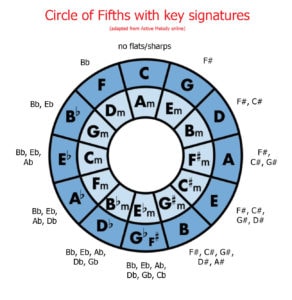
Circle of Fifths for (Ionian) Major keys. (Relative Major and Minor chords are in the centre of the green area.)
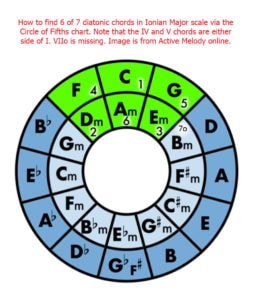
Circle of Fifths for (Aeolian) Minor keys
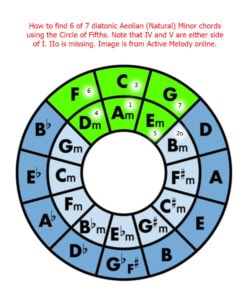
Circle of Fifths – borrowing from a parallel key (Ionian / Aeolian) for modal mixture.

Circle of Fifths – finding secondary dominant chords.
